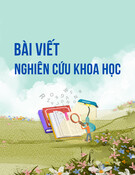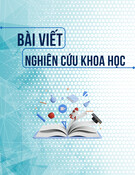
Tạp chí Khoa học - Số 80/Tháng 1 (2024) 115
SOME DIFFICULTIES IN TRANSLATION WORD BY WORD
FROM ENGLISH - TO VIETNAMESE AND VICE VERSAL
Nguyen Thi Bich Lien
Trường Đại học Thủ đô Hà Nội
Abstract: To equip students with the necessary English language proficiency and translation
skills to function in multilingual environments, translation and interpretation are significant
components of English language studies programs. However, carrying out a successful
translation is not a simple undertaking because there are other aspects at play in addition to
one's proficiency in the English language. Due to their inadequate language ability and
comprehension of translation processes, many Vietnamese English Foreign Language (EFL
college students lack significant expertise in translation and interpretation. Additionally,
only those learners are exposed to situations where translation is necessary. They all make
major contributions to the outputs' poor translation quality. The purpose of this article is to
examine the translation processes used by Vietnamese EFL college students as well as the
effectiveness of the translated versions in comparison to the original Vietnamese papers. The
results of analyzing 10 translated texts from 10 participants show a significant percentage of
inaccurately translated things brought on using a word-by-word translation method and the
effect of the Vietnamese language. To assist educators and students in changing the
curriculum and teaching strategies, advice is offered.
Key words: curriculum, interpretation, language ability, multilingual environments,
proficiency, translation.
Nhận bài ngày 12.12.2023; gửi phản biện, chỉnh sửa và duyệt đăng ngày 26.01.2024
Liên hệ tác giả: Nguyễn Thị Bích Liên; Email: ntblien@daihocthudo.edu.vn
1. INTRODUCTION
Since English is the most widely spoken language in this era of globalization, an increasing
number of English language learners are looking for jobs in multinational and multilingual contexts.
Higher education institutions provide English language programs that enable students to research
many facets of the language and enroll in professional courses for their future job pathways because
they are very conscious of the requirement for language learning. English Translation and
Interpretation is one of the key research areas now, and it teaches students the skills and understanding
of the English language necessary for successful translation and interpretation. The university provides
four courses in translation and interpretation that give students the chance to learn about translation
theories and put those theories into practice.
Despite having plenty of time to immerse themselves in the subject, difficulties with translation
and interpretation still arise. Vietnamese EFL college students face a variety of difficulties while
studying and performing translation due to their inadequate English ability and lack of expertise.
Learning the English language later in life, having little previous knowledge of the topics being
translated, and having few opportunities to practice translation in a genuine setting are a few reasons
why students struggle with their translation assignments. Additionally, there are some inefficiencies in
their institution's teaching and learning processes that hinder students' ability to translate. In this essay,
I will study the definitions and components of effective translation practices, as well as the efficacy of

116 TRƯỜNG ĐẠI HỌC THỦ ĐÔ HÀ NỘI
learners' translation outputs, to better understand the learners' present translation practices and their
ability to translate.
2. THE CONTENTS
2.1. The definition of translation
Although they are frequently linked, translation and interpretation are not the same. To determine
the parallels and differences between the two issues, this section will examine their definitions. It is
also important to highlight that this paper solely focuses on the first.
Due to their widespread use, translation and interpretation are well-known to the public, and the
two professions have been extensively defined. Translation was described by Heim and Tymowski
(2006) as the act of converting a text from one language to another, regardless of the text's format [1].
Since a text can be created in both spoken and written formats, which require distinct translation
procedures, this term is broad. Other scholars who have a more in-depth understanding of translation
have based their definitions on the many kinds of texts. The two concerns were very simply clarified
by Jones (2002) [2] and the European Commission (2009) [3], who said that while both phrases refer
to converting messages from one language to another, translation focuses on written language while
interpretation is in spoken form. The formats of the texts and communications that individuals convert
from one language to another have made the main distinction between translation and interpretation
clearer.
The criteria to obtain accurate translation and interpretation are various because of the variations
in the text forms. The features of a successful translated work and the standards that translators must
meet are illustrated in the section that follows.
2.2. Translation and translator’s requirements
Translation, according to Jones (2002) [2], entails more than merely transcribing words from one
language into another. Translation ought to be connected to clear communications in the target tongue.
The translation should give its audience the impression that it was originally written in the target
language rather than being translated. While Paul (2009) [4] [3] and the European Commission (2009)
placed more focus on the accuracy of the material, Jones (2002) placed more emphasis on the
consistency and continuity of the translation [2]. It is also argued that due to their accuracy in content,
translated papers should be given the same legal weight as the original. Therefore, accurate content,
consistency, and cohesiveness are necessary for good translation to guarantee the readability and
comprehension of the translated documents.
These previously mentioned qualities of good translation have led to the establishment of certain
standards for translators. According to Jones (2002) [2], since translation is done in writing, translators
should have great writing and editing skills to produce high-quality translated works. Good language
abilities alone, however, are insufficient. The European Commission (2009) did a significant amount
of work on the characteristics of good translators and exposed some myths about what makes a good
translation [3]. To give an example, speaking two or more languages does not automatically make one
able to translate between them. A good translator should be able to fully comprehend the messages
they are translating. This is especially true in instances of specialized translation (Jones, 2002), where
translators work on texts from certain disciplines like nursing, engineering, or sociology and must
possess a thorough understanding of the subject to accurately translate the messages [2]. Jones (2002)
stipulates that after obtaining translation assignments, translators must hunt for additional information
to make sure they fully understand the concepts of the source writings. The criteria to obtain accurate
translation and interpretation are various because of the variations in the text forms. The features of a
successful translated work and the standards that translators must meet are illustrated in the section
that follows [2].
Being a professional translator requires a lot of expertise and work because there are high
standards for translation quality. Jones (2002) and Robinson (2007) expanded on this topic by
highlighting the professional preparation that aspirants to the field of translation should get through
their training programs. A translator may specialize in one field, such as conference, escort, literary,

Tạp chí Khoa học - Số 80/Tháng 1 (2024) 117
medical, or judicial translation. Knowing their area of interest can help translators focus their time and
energy on learning the language and, more significantly, developing specialized expertise in that area.
The efforts to develop a thorough understanding of several disciplines and English language
proficiency, including terminology, should be multiplied by those who seek to broaden their
translation careers to several disciplines. Another issue is localization, which necessitates that
translators become familiar with the contexts of both the original and translated works. This complex
guidance attempts to assist translators in completely understanding the information conveyed as well
as offer understandable messages to a particular audience. Training programs, as indicated by
Robinson (2007), should educate students on translator ethics. As a bridge between speakers of other
languages, translators are responsible for preserving the integrity of the original texts in their work.
The topic of translator professional involvement was further discussed by Robinson (2007) since there
is a belief in lifelong learning and gaining expertise. To put it another way, translators should join a
professional organization in their sector to share experiences and get opportunities to practice.
What translator groups or unions we belong to, what translator conferences we attend, what
courses we take in the field, and how we network with other translators in our region and language
pair are all matters of little to no significance to translation users but of tremendous relevance to
translators (s). Sometimes these "involvements" assist translators in improving their translations,
which is crucial for users and consequently for the pride we take in trustworthiness. However, more
importantly, they improve our confidence in our abilities as translators, which helps us get through
tedious, repetitive, and low-paying work since it gives us more motivation.
Given the aforementioned, becoming a skilled translator and attaining good translation are
difficult and demanding tasks. The issue is how well-aware of these traits’ persons undergoing
translation training are, and how these traits are represented in their translation assignments. The
abilities of Vietnamese EFL college students to produce quality translation outputs and the motivations
underlying their translation are examined in the section that follows.
2.3. Research methodology
I put out the following research questions to find out how Vietnamese EFL college students
approach their translation assignments and whether the results match the standards previously
mentioned:
- How do college-aged Vietnamese EFL students approach their translation assignments?
- How well are such translation projects carried out?
- Why do they translate in the ways that they do?
Ten English-major students who were juniors at the time of the data collecting stage participated
in the study. Due to their success in their training program's Introduction to Translation and
Interpretation and Translation 1 courses, those junior students were chosen. Before they participated in
this study, it was thought that they had a certain awareness of translation theories and processes.
According to the reports, those individuals earned at least a B+ in both their English language
competence and translation-related courses, demonstrating their high level of English proficiency and
comprehension of translation techniques.
The participants had to translate into English an excerpt from a Vietnamese text that discussed
English language instruction at the university level. The piece was chosen from a reputable publication
called "Tuoi Tre," and the participants were familiar with the subject.
I asked the instructors of those Translation courses to cross-evaluate the participants' translated
texts when the translation was finished. These professors have extensive teaching backgrounds and
oversee the Translation and Interpretation courses at the institution under study. At Vietnam National
University, Hanoi, they also took part in several training programs in translation and interpretation.
Their assessment was valuable and trustworthy because they were knowledgeable and well-trained.
To highlight the inadequacy of the translated items, the translated texts were compared to the
Vietnamese source document. I then spoke with those participants in interviews to gain deeper insights

118 TRƯỜNG ĐẠI HỌC THỦ ĐÔ HÀ NỘI
on translation practices.
3. Some findings and discussions
3.1. Translated texts
The word-by-word translation method used by the participants and the Vietnamese language's
effect, which resulted in improper word choices, demonstrated that the participants' translations still
had significant issues. Inaccurate translation was sometimes a result of not understanding the original
language's meaning. I gave several illustrative examples of their improper translation in this section of
the text.
No
Original
words
Participants’
Translation
Comments
1
Nỗi ám ảnh
Obsession
Several participants mistranslated this because "the fear"
should be understood in this context. However, this incorrect
translation resulted from not being able to use the word in the
appropriate context.
2
Cựu sinh
viên
Old students
Since "the fear" should be understood in this context,
numerous participants mistranslated this. The translation was
incorrect, though, because the word couldn't be used in the
appropriate context.
3
Sụp hố
Stepping into a hole
Another instance of literal translation without consideration of
context was this one. In this instance, "sụp hố" implies "feeling
depressed or surprised," but the participants' translations
changed the phrase's connotation.
4
Chuẩn bị
tâm lý
Preparing their
psychology
Another illustration of word-by-word translation is this. The
phrase "being ready to deal with the challenges" appears in the
original text. Nevertheless, the sentence was broken up and
each word was translated, for example, "preparing" for "chuẩn
bị" and "psychology" for "tâm lý"
5
Người bản
xứ
Local people
Being unfamiliar with the Vietnamese phrase was the cause of
this inaccurate translation. In this situation, "Người bản xứ"
refers to Native English speakers, but the participants gave
"local people," which was inappropriate.
Additional samples taken from the participants' translations demonstrated the word-by-word
method's inequivalence un translation. In these examples, I used the numbers to show how closely the
participants followed the Vietnamese text and employed a word-for-word translation method.
Original text:
Bản thân quá chú trọng ngữ pháp trong khi nghe yếu, nói dở, chỉ có đọc hiểu, viết là kha khá.
(1) (2) (3) (4) (5) (6) (7) (8) (9)
Participant’s translation:
Individuals too focus on grammar while listening is weak, speaking is bad, only reading and
writing are fair.
(1) (2) (3) (4) (5) (6) (7) (8) (9)
Suggested translation: Only the students' reading and writing abilities are actually quite good;
they tend to focus more on grammar and disregard their listening and speaking abilities.

Tạp chí Khoa học - Số 80/Tháng 1 (2024) 119
This example demonstrates how the participant interpreted each word without considering how to
change the sentence's structure to make it flow more naturally. The following is another example of
how a word-by-word translation muddied the meaning of the sentence.
Original text:
Để sử dụng tiếng Anh cho một cơ hội nghề nghiệp tốt, môi trường sách vở, lớp học thôi chưa đủ.
(1) (2) (3) (4) (5) (6)
Participant’s translation:
To use English for a good career chance, environment, books, classes are not yet enough.
(1) (2) (3) (4) (5) (6)
Suggested translation: Learning from books and classes alone won't prepare students for the
workplace or allow them to utilize English successfully.
Insufficient translation was done, which caused the translated paragraphs to be incoherent and
distort the original communications' meaning.
3.2. Interviews
This example demonstrates how the participant translated each word without taking sentence
structure into account to make the sentence flow naturally. The following line is another illustration of
how word-for-word translation muddied the meaning. The interviews also make clear that they were
not aware of the original text's intended meaning. Some participants acknowledged that they did not
understand the meaning of the Vietnamese sentences, but they did not ask for assistance in getting
those points clarified. They just translated those based on their own interpretations, which did not
correspond to the original meaning.
Some participants stated that they were unable to perform the translation well due to their low
language skills. As an illustration, one participant said that, because to her limited vocabulary, she was
unable to translate the original material into English even though she understood it completely. She
also acknowledged that she occasionally doubted the accuracy of her word choices.
The time restriction and the level of translation were brought up by another participant.
According to him, there shouldn't be great expectations for the quality of the translation because he
had a very constrained amount of time to complete it. Iverson (2004), who discovered a relationship
between time and quality, is pertinent to this topic. Since translators won't have enough time to revise
their work, the desired level of quality might not be achieved.
All participants, according to the literature, did not successfully translate the material related to
their field of study, although having completed their translation and language skills courses with
satisfactory results. As a result, the participants' ignorance of the original materials prevented the
correctness of the content from being guaranteed. They have also chosen to continue with the Vietnamese
version and adhere to the word-for-word translation to prevent content distortion due to their inadequate
language competence and lack of confidence. However, the meaning of the communications had already
been changed or even rendered ambiguous by this word-for-word translation.
4. CONCLUSION
A study demonstrates that the participants' attempts at translation are unsuccessful because they
lack understanding of the original text's meaning, have poor English language skills, misuse the word-
by-word translation method, and lack confidence when changing sentences. As a result, instructors
must use a variety of tools to raise the language and background knowledge of their students.
Additionally, there must be more chances for translators to put their skills and confidence to the test.
Robinson (2007) advised that the institution start translation clubs so that instructors and students
would have a place to practice and share experiences. It is also possible to engage seasoned translators
to give pupils practical translating practice. Being a professional translation requires hard work and
effort rather than comfort. As a result, to increase their ability to translate, both teachers and students
need to make the courses more practical with lots of practice chances.

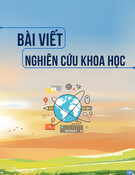
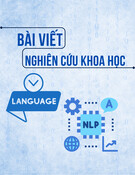



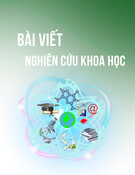
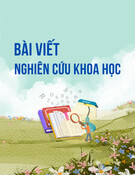
![Phương pháp dóng hàng câu tự động cho văn bản Trung Quốc cổ điển - Việt Nam hiện đại [chuẩn SEO]](https://cdn.tailieu.vn/images/document/thumbnail/2025/20250715/nomoney11/135x160/99021752553566.jpg)
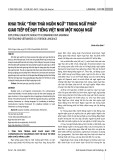
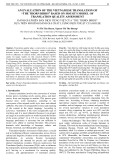
![Bộ câu hỏi trắc nghiệm Văn bản tiếng Việt [chuẩn nhất]](https://cdn.tailieu.vn/images/document/thumbnail/2025/20251127/thuynhung051106@gmail.com/135x160/24021764296609.jpg)
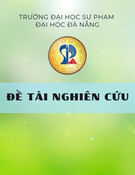

![Bài giảng Ngôn ngữ học đối chiếu Nguyễn Ngọc Chinh [PDF]](https://cdn.tailieu.vn/images/document/thumbnail/2025/20251101/vovu03/135x160/7471762139652.jpg)
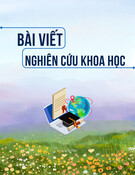
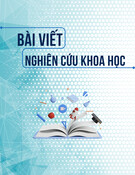
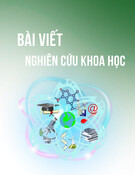
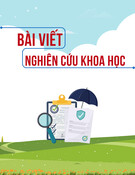
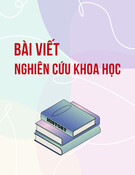
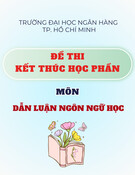
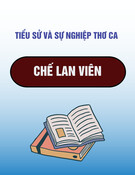
![Ngân hàng câu hỏi môn Tiếng Việt thực hành [chuẩn nhất]](https://cdn.tailieu.vn/images/document/thumbnail/2025/20251003/kimphuong1001/135x160/21861759464951.jpg)
![Bài giảng Văn học phương Tây và Mỹ Latinh [Tập hợp]](https://cdn.tailieu.vn/images/document/thumbnail/2025/20251003/kimphuong1001/135x160/31341759476045.jpg)
